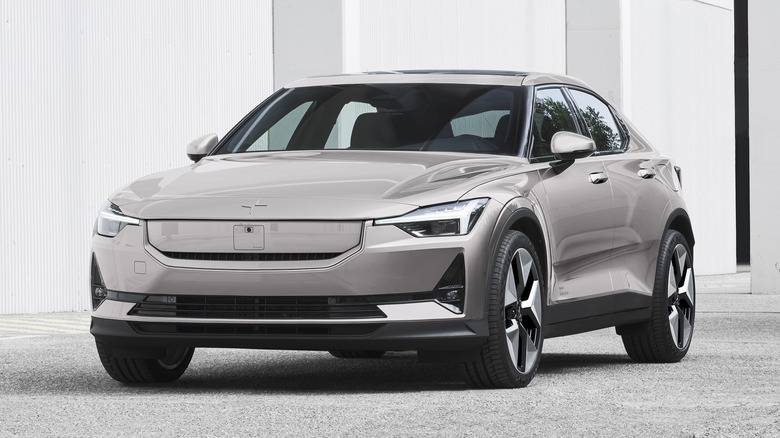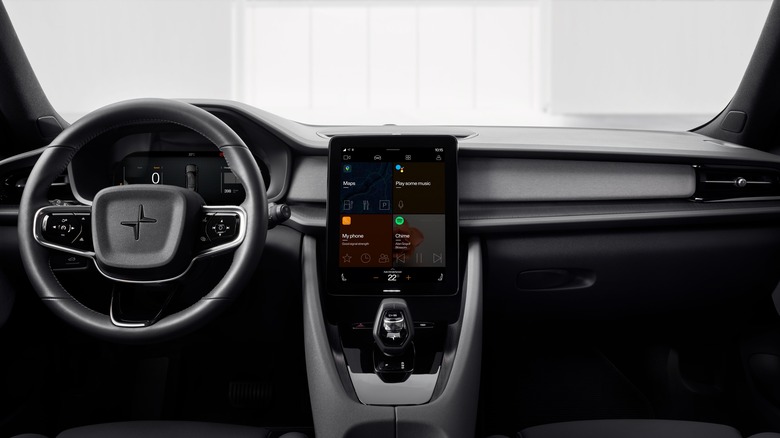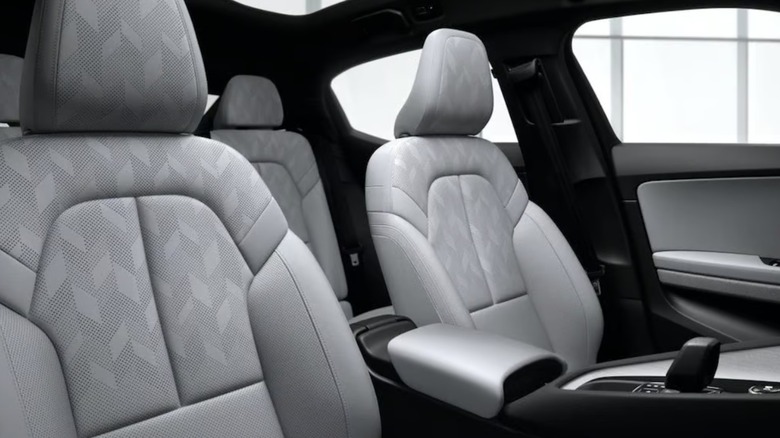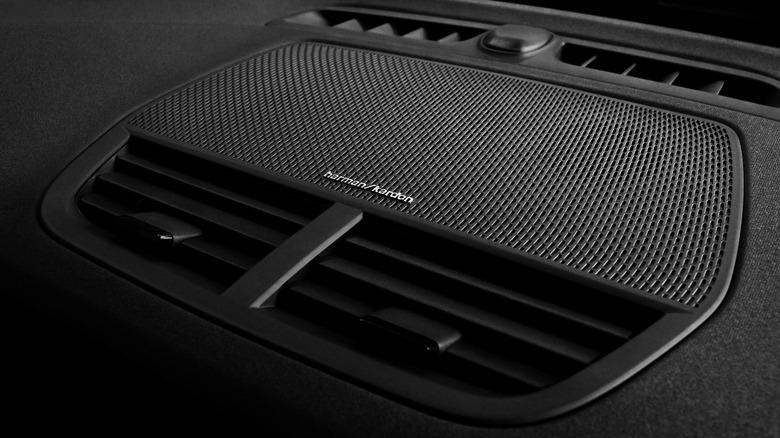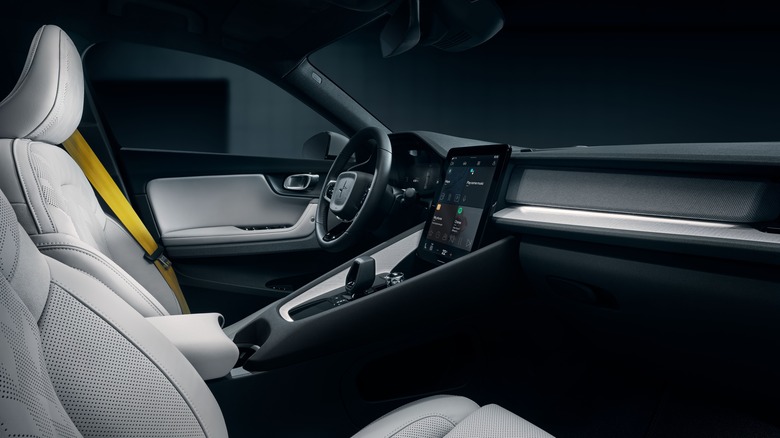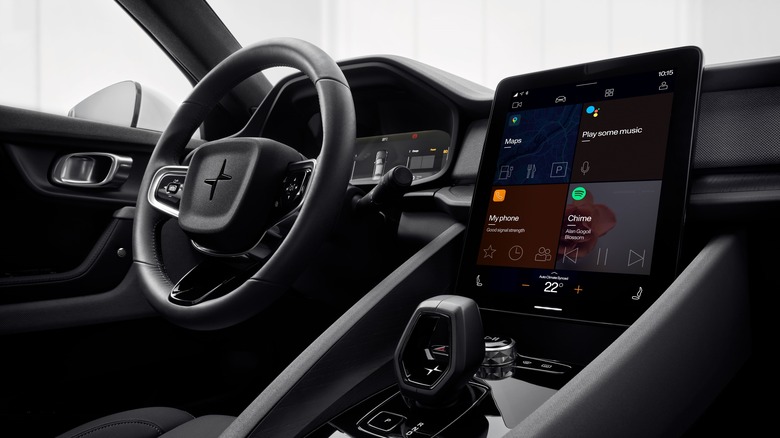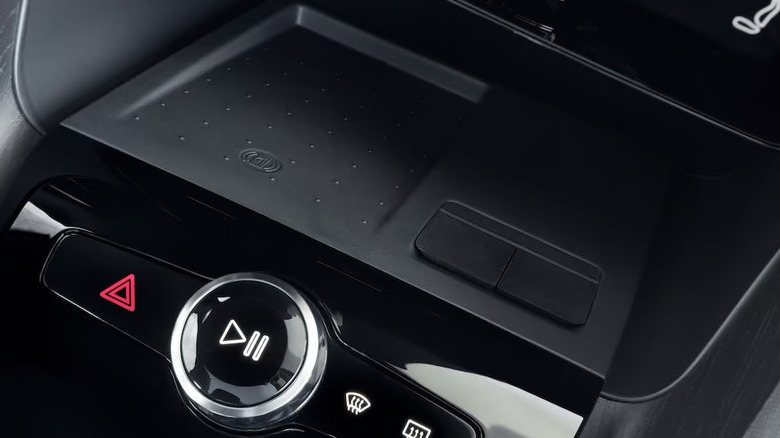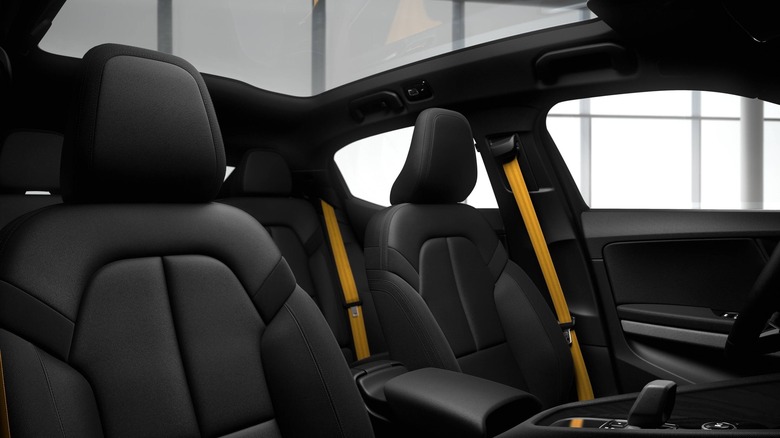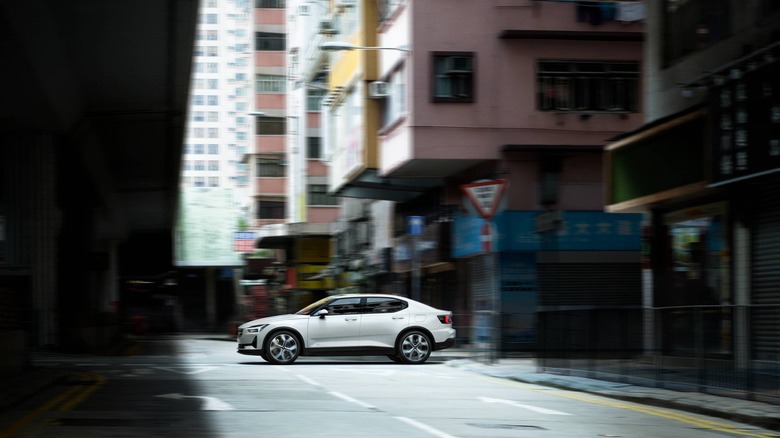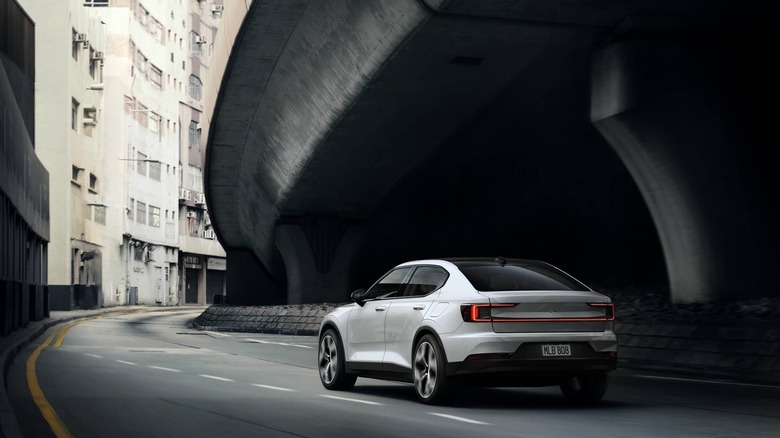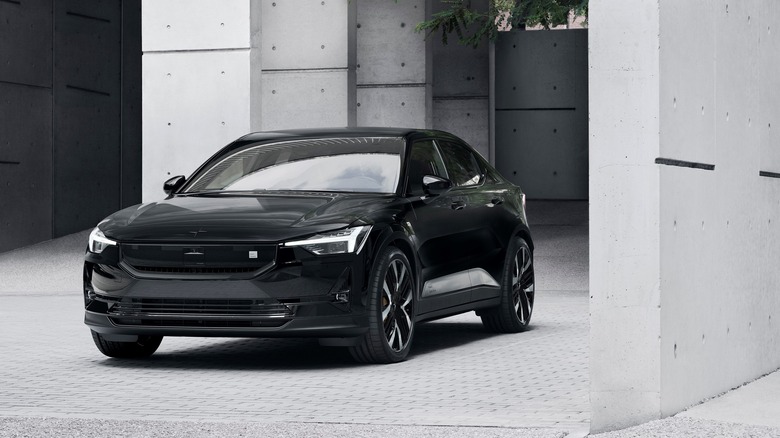The Coolest Features Of The Polestar 2 Interior
It might be one of the newer names on the EV scene, but Polestar has the backing of Chinese conglomerate Geely, which means it has avoided many of the teething troubles other EV startups have faced. It first rose to prominence as the performance division of Volvo, but after Polestar was spun off into a separate sub-brand, it launched a line of all-electric vehicles aiming to take on the likes of Tesla in the premium EV space. The most affordable of its current production lineup is the Polestar 2, which benefited from a range of mechanical and styling upgrades for the recently-unveiled 2024 model year.
The new model year saw very few changes to the inside of the car, but in this case, that's no bad thing. Polestar's cabin offers a mix of Tesla-style minimalism mixed with Swedish chic, and much like Tesla's interior, it's packed with features that aim to make everyday driving more convenient and comfortable than its competition.
Driver recognition
If you share a car with several other people, it can be a real pain having to adjust seats, mirrors, and infotainment systems to your preference every time you get in the car. The Polestar 2 does away with that by recognizing your key fob or smartphone whenever you approach the car, automatically adjusting things so they're ready as soon as you're ready to drive off. Alongside the usual seat and mirror adjustments, the car also automatically changes the steering feel, and can enable or disable one-pedal driving.
If you like listening to a particular playlist while you're driving, you can also set it up to automatically start playing every time you enter the car. Likewise, if you prefer to listen to a certain radio station, the car has that covered too, and will automatically tune in as soon as you unlock the doors. Playlists, podcasts, and any other media can all be streamed without using your mobile data — for the first three years of ownership, Polestar covers all your in-car data costs.
Vegan WeaveTech seats
Adding the optional Plus Pack gets you a range of interior upgrades, one of which is the WeaveTech seat upholstery. WeaveTech is a vegan fabric that Polestar is keen to point out is not "fake leather," like many other EV rivals use in their cabins. Instead, it's an innovative material designed to reduce waste in the manufacturing process as much as possible, using around 45 times less chemical plasticizer than typical fake leather. It's paired with "Black Ash deco" wood inserts around the cabin, which uses a low-gloss stain to reduce the amount of wood that gets wasted in the manufacturing process.
Both the front and rear seats include heating systems with the Plus Pack, alongside a heated steering wheel and heated washer fluid nozzles to keep the system running reliably in cold conditions. All nice-to-have features, but they do come at a cost — the Plus Pack costs an extra $4,200 on top of the car's base price.
Harman Kardon audio system
Another perk of the Plus Pack is the sound system by Harman Kardon, which can deliver up to 600 watts of car-filling sound. That's achieved through the 13 speakers placed strategically throughout the car, with Polestar working with the audio specialists to ensure that occupants in both the front and rear rows get an equally immersive experience. The subwoofer is particularly unusual in that it's not actually mounted in the cabin at all, but rather in the rear wheel housing.
It's fully air ventilated, allowing for much lower bass notes than a standard in-car system could produce while minimizing the noise on the outside of the car. Polestar says the system sounds just as good whether you're playing classical music or EDM, with Dirac Unison tuning software that can adapt to the subtleties of any track. Even if you're not a dedicated audiophile, the superior sound quality makes it worth the upgrade — unless, of course, you're only planning on listening to podcasts on your morning commute.
Ambient interior lighting
While Polestar certainly isn't the first company to include ambient lighting in its cars, the way its designers have gone about the process of integrating it into the cabin is unique. For starters, there are no color-changing lights here — the Polestar 2 keeps things clean and minimal, with soft white lighting that aims to make it easy to find things in the dark without it ever being distracting. These lights are integrated into the cabin in a way that you wouldn't even notice they were there at first glance, to keep things as sleek as possible.
In addition to the general ambient lighting, the Polestar 2 also features extra lights in various key areas to highlight specific controls. The gear selector, for example, features an illuminated Polestar logo in the base, drawing your eye to it in the dark. Not that it serves any real benefit to the driver in this case — it's just there to look cool, and it does exactly that.
The first car with Android Automotive OS
Most carmakers develop their own infotainment OS systems, adding integration features for smartphones from Google and Apple — but not Polestar. Instead, the brand partnered with Google to develop a native Android Automotive OS for the Polestar 2, the first of its kind. This means features like Google Maps and Google Assistant are native to the car and can be used without needing to connect your smartphone. Using Google Maps will also integrate charging points into your navigation route if necessary.
Drivers with iPhones don't need to sacrifice connectivity either, as Polestar also supports Apple CarPlay too. Alongside Google's navigation and hands-free functions, Polestar has also partnered with a number of other companies to make everyday driving as hassle-free as possible. A Polestar-specific version of Waze is integrated as an alternative navigation guide, and the EasyPark app lets you pay for a parking space in thousands of parking lots without having to use your smartphone or find a meter. As soon as you pull out of your spot to head home, EasyPark will automatically stop your payments, so you'll still only pay for the amount of time you use.
Wireless phone charging
Both the driver and passengers have plenty of space to charge their phones, tablets, or other portable devices on the go, as the Polestar 2 offers four USB-C ports as standard. Two of those ports are located in the center console for easy access for the driver and front-seat passenger, while the other two are located under the rear air vents. The wired charging ports can deliver up to 15W, so fast charging will be out of the question assuming you've got a recent flagship phone.
If you opt for the Plus Pack, you'll also get a wireless charging pad in the center console, with small sidewalls to keep your phone firmly in place while you're driving. Alongside phones, the pad will charge any device that supports the Qi wireless charging standard, so if you've got wireless earbuds or any other compatible gadgets, you can keep them topped up too.
Panoramic glass roof
Polestar also offers a glass roof on both cars in its current lineup, albeit only as an optional extra. It's available as part of the Plus Pack, and can't be added as a standalone option. Polestar says the roof glass is able to reduce 99.5% of UV radiation and outside noise, plus it can transfer heat away from the cabin to cool it on hot days. There's no retracting curtain for extra shade, but Polestar claims that's to increase headroom in the rear of the cabin.
The company has not made any official claims concerning the strength of its glass roof, but competitor Tesla has gone to great lengths to reassure customers that having glass over your head instead of metal is not any less safe. Specifically, Tesla claims that its glass roof can hold up to four times the car's mass before failing, and even if it does fail, it won't shatter. So, there's no reason to think that a glass roof is any less safe than a metal-roofed car.
Automatic particulate filter
If all the other Plus Pack features still haven't persuaded you to fork out the extra $4,200, the upgrade also includes a particulate filter that can detect pollen and pollutants and extract them before they get to the cabin. If you've driven a Tesla, this may sound very familiar – Bioweapon Defense Mode performs a similar function. A readout of the air quality inside the cabin can be viewed through the central touchscreen, which also gives live information on outside levels of airborne pollutants.
Polestar has also promised that an innovative new feature will soon be introduced where drivers can pre-filter the cabin air by using the Polestar app, cleaning it while the car is parked. Similarly innovative is the heating system, which uses a heat pump to recapture excess heat from the battery and powertrain. That heat is captured and pumped into the cabin, a more efficient method than using a traditional electric heater. If used over a longer period, the added efficiency could even extend the range of the car, according to Polestar.
Semi-autonomous driving with Pilot Pack
Plenty of EVs now pack semi-autonomous driving features, but most of the Polestar 2's most capable systems are only unlocked by paying for the Pilot Pack. This is slightly cheaper than the Plus Pack, adding $3,400 to your overall payment. Optioning in both packs will add up to a premium of $7,600, a hefty addition considering the car starts at $49,800. Still, the Pilot Pack is worth it if you're looking to let your car do as much of the driving for you as possible, with features like Pilot Assist and Adaptive Cruise Control making long highway drives easier.
Safety features like rear cross-traffic alert, blind spot assistance, and 360-degree parking sensors are also only available with the Pilot Pack. Another useful addition is the self-dimming mirror function, which acts across both the wing mirrors and the rearview mirror to protect you against bright lights. The system is activated automatically when the car detects that it's dark outside.
Over-the-air software updates
To ensure that the Polestar 2's software remains cutting-edge in the future, the car supports over-the-air software updates. Not only is this great for keeping the UI looking fresh, but it also lets Polestar issue instant hotfixes to correct any bugs or issues that might arise over time. Tesla recently proved how useful the OTA system is when it issued a fix for its Full Self-Driving safety recall without needing to call any of the 360,000 cars affected into its service centers.
Polestar also has another unique use for updates like this: In 2021, the company unveiled a downloadable update that could add more horsepower to the car for a fixed fee. It gave the car a significant performance boost too, with 67 additional horsepower and an extra 15 pound-feet of torque available. When we drove the 2021 Polestar 2, we thought its stock 408 horsepower was more than enough, but for anyone looking for maximum performance, a simple download is all that's needed.
